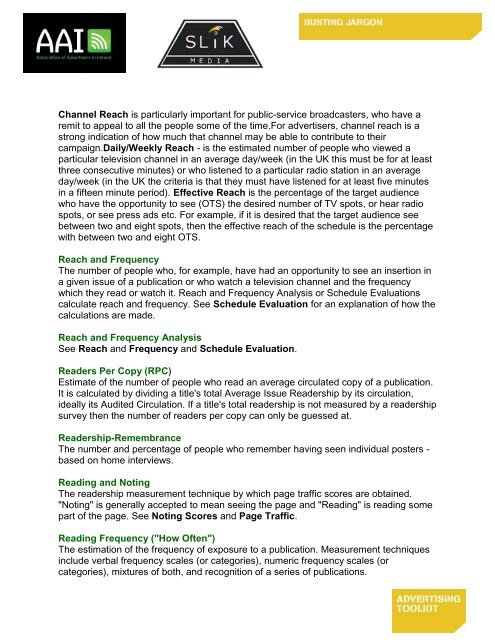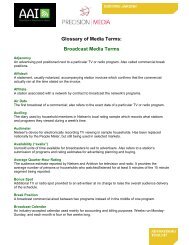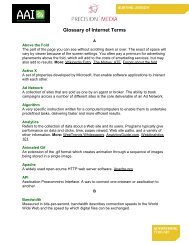Definitions, Abbreviations and Jargon - Association of Advertisers in ...
Definitions, Abbreviations and Jargon - Association of Advertisers in ...
Definitions, Abbreviations and Jargon - Association of Advertisers in ...
Create successful ePaper yourself
Turn your PDF publications into a flip-book with our unique Google optimized e-Paper software.
Channel Reach is particularly important for public-service broadcasters, who have a<br />
remit to appeal to all the people some <strong>of</strong> the time.For advertisers, channel reach is a<br />
strong <strong>in</strong>dication <strong>of</strong> how much that channel may be able to contribute to their<br />
campaign.Daily/Weekly Reach - is the estimated number <strong>of</strong> people who viewed a<br />
particular television channel <strong>in</strong> an average day/week (<strong>in</strong> the UK this must be for at least<br />
three consecutive m<strong>in</strong>utes) or who listened to a particular radio station <strong>in</strong> an average<br />
day/week (<strong>in</strong> the UK the criteria is that they must have listened for at least five m<strong>in</strong>utes<br />
<strong>in</strong> a fifteen m<strong>in</strong>ute period). Effective Reach is the percentage <strong>of</strong> the target audience<br />
who have the opportunity to see (OTS) the desired number <strong>of</strong> TV spots, or hear radio<br />
spots, or see press ads etc. For example, if it is desired that the target audience see<br />
between two <strong>and</strong> eight spots, then the effective reach <strong>of</strong> the schedule is the percentage<br />
with between two <strong>and</strong> eight OTS.<br />
Reach <strong>and</strong> Frequency<br />
The number <strong>of</strong> people who, for example, have had an opportunity to see an <strong>in</strong>sertion <strong>in</strong><br />
a given issue <strong>of</strong> a publication or who watch a television channel <strong>and</strong> the frequency<br />
which they read or watch it. Reach <strong>and</strong> Frequency Analysis or Schedule Evaluations<br />
calculate reach <strong>and</strong> frequency. See Schedule Evaluation for an explanation <strong>of</strong> how the<br />
calculations are made.<br />
Reach <strong>and</strong> Frequency Analysis<br />
See Reach <strong>and</strong> Frequency <strong>and</strong> Schedule Evaluation.<br />
Readers Per Copy (RPC)<br />
Estimate <strong>of</strong> the number <strong>of</strong> people who read an average circulated copy <strong>of</strong> a publication.<br />
It is calculated by divid<strong>in</strong>g a title's total Average Issue Readership by its circulation,<br />
ideally its Audited Circulation. If a title's total readership is not measured by a readership<br />
survey then the number <strong>of</strong> readers per copy can only be guessed at.<br />
Readership-Remembrance<br />
The number <strong>and</strong> percentage <strong>of</strong> people who remember hav<strong>in</strong>g seen <strong>in</strong>dividual posters -<br />
based on home <strong>in</strong>terviews.<br />
Read<strong>in</strong>g <strong>and</strong> Not<strong>in</strong>g<br />
The readership measurement technique by which page traffic scores are obta<strong>in</strong>ed.<br />
"Not<strong>in</strong>g" is generally accepted to mean see<strong>in</strong>g the page <strong>and</strong> "Read<strong>in</strong>g" is read<strong>in</strong>g some<br />
part <strong>of</strong> the page. See Not<strong>in</strong>g Scores <strong>and</strong> Page Traffic.<br />
Read<strong>in</strong>g Frequency ("How Often")<br />
The estimation <strong>of</strong> the frequency <strong>of</strong> exposure to a publication. Measurement techniques<br />
<strong>in</strong>clude verbal frequency scales (or categories), numeric frequency scales (or<br />
categories), mixtures <strong>of</strong> both, <strong>and</strong> recognition <strong>of</strong> a series <strong>of</strong> publications.









